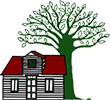The Green Giant Challenge
22 May 2020
How many Green giants does Paramaribo have?
Within the project we would like to map the large trees in the Paramaribo district.
For now we focus on the well-known Kankantri (Ceiba pentandra) and the so-called Rain Tree (Samanea saman).
Do you know where to find one or more of these trees?
Discover the Green Giants of Paramaribo!
Capture a picture of a Kankantri or a Rain Tree and
share these on your Facebook wall with the title:
"Look! A Kankantri (or Rain Tree)"
Indicate the location as precise as possible on your photo and tag 1 or 2 friends with:
"Go find your big tree @friend!"
In that way they can also search for the giants and share them on their wall.
Don’t forget to mention the hashtags
#groenparamaribo #reuzenbomen #groensamendoen #tropenbossuriname
Do you come across a very large tree but have no idea what kind of tree it is?
Don't worry, we are happy to help with the descriptions.

The Samanea saman, known in Suriname, as the Rain Tree, is a fast grower and is part of the family Fabaceae and the subfamily Mimosoideae. It reaches a height of 15-25 meters with a very large crown of almost 30 meters in diameter. The name "rain tree" is due to this appearance.
The Rain Trees often have epiphytes in them. These trees are often confused with the flamboyant trees. However, no epiphytes grow in the flamboyant trees. The small flowers grow to about 4 centimetres in size and are pink in color, the flower which is central in a cluster of 12-25, is larger with more petals and has a nectar-producing organ that attracts pollinators. Their fruits resemble the “swit bontji” but black brown in color, filled with a sticky brown flesh which is edible.
Their origin is mainly from the northern part of South America and is also found in the tropics. It occurs naturally in savanna areas with grass plains and deciduous forests near transitions. It certainly adapts to a variety of soil types and pH.

These trees are very suitable for large public spaces such as parks and school grounds because of the shade it offers. The leaves are light sensitive and close together when cloudy, so that the rain can reach the ground through the crown.
Resource: https://www.researchgate.net/publication/311667816_Samanea_saman_rain_tree

---



The Ceiba pentandra, Kankantri, becomes a giant straight tree that can be recognized by the plank roots, which in themselves reach a height of 3 to 8 meters. The bark is smooth and gray in color and the branches grow horizontally like an umbrella.
The kankantri can tolerate a lot of rain for good growth and dry periods to blossom. The trees can easily fall over by strong winds because they belong to the light wood species.

The young kankantri trees have spines on their bark. The leaves are compound and elongated, which fall off for a period of time. In the same period, the kankantri can also bloom, releasing the flowers. These look similar to small white fluff.
Resource: https://www.prota4u.org/database/protav8.asp?g=pe&p=Ceiba+pentandra+(L.)+Gaertn.


